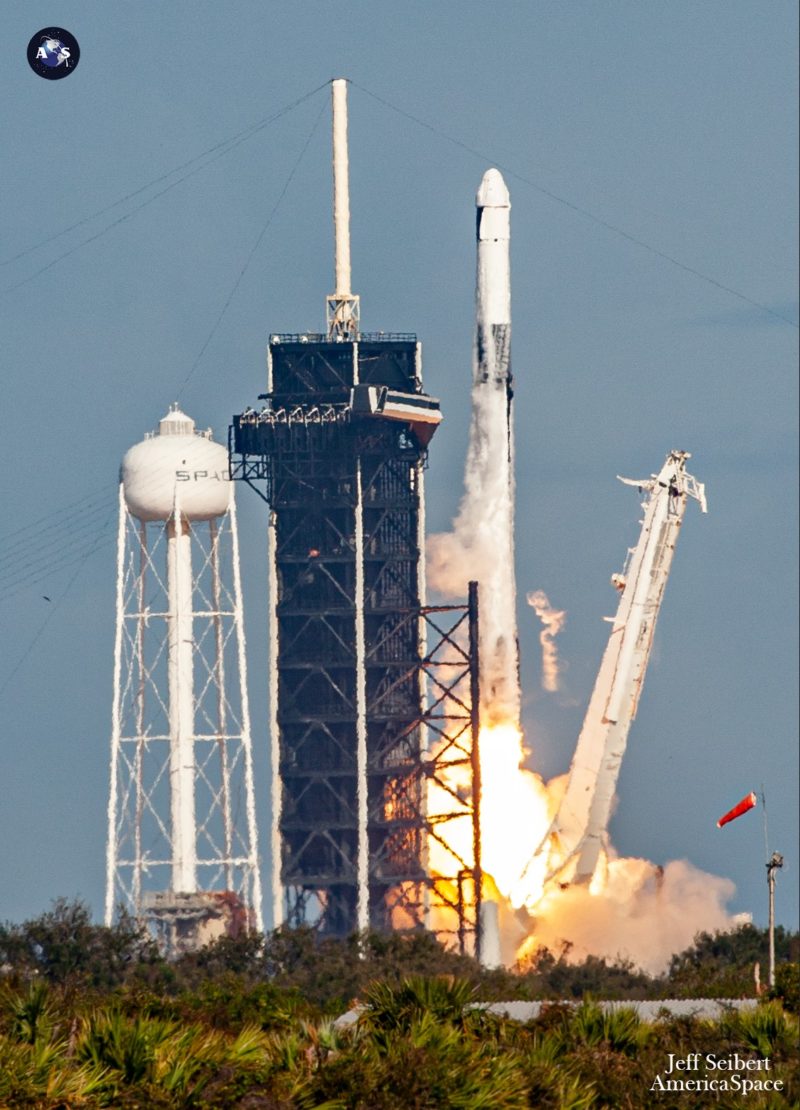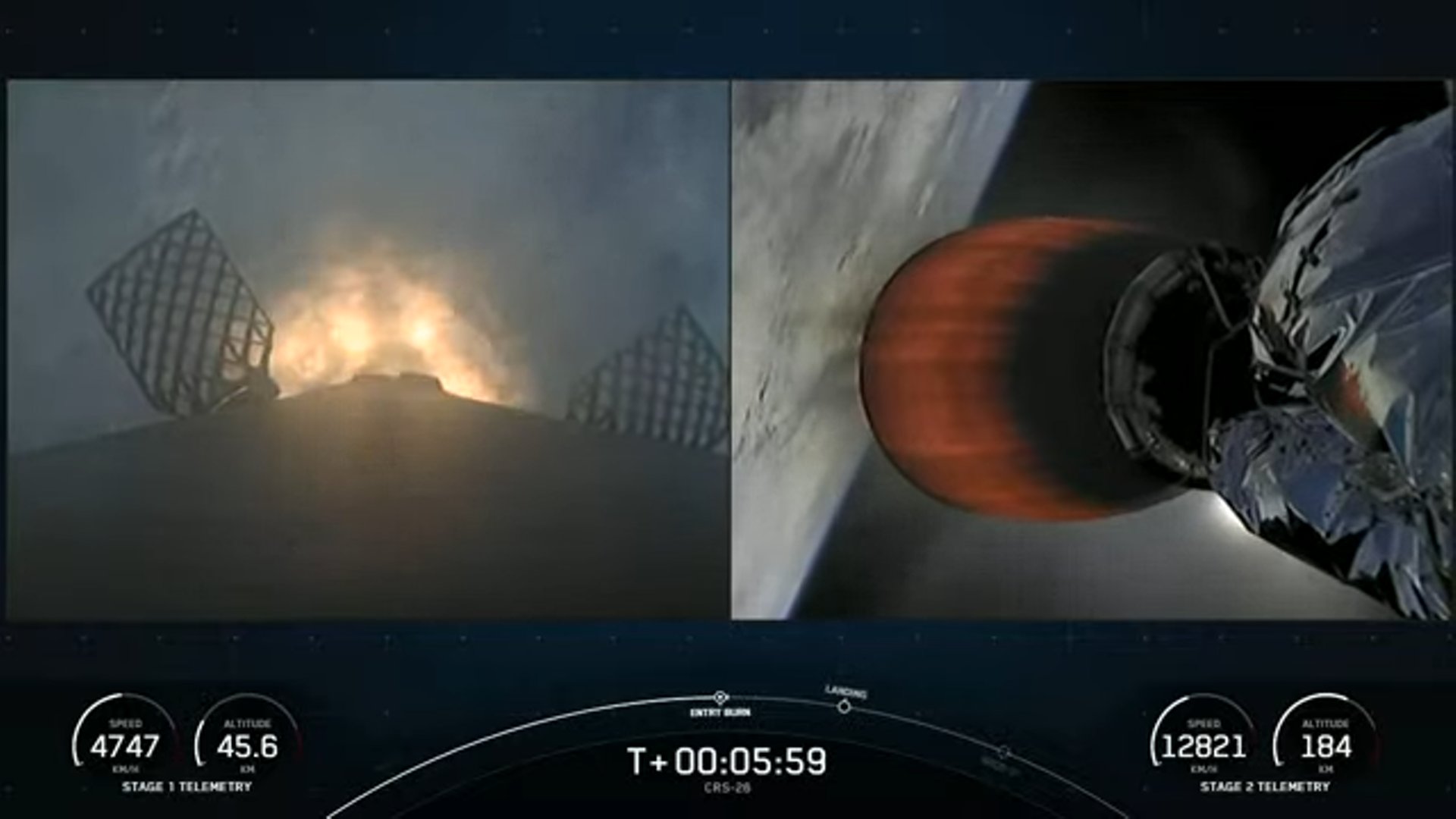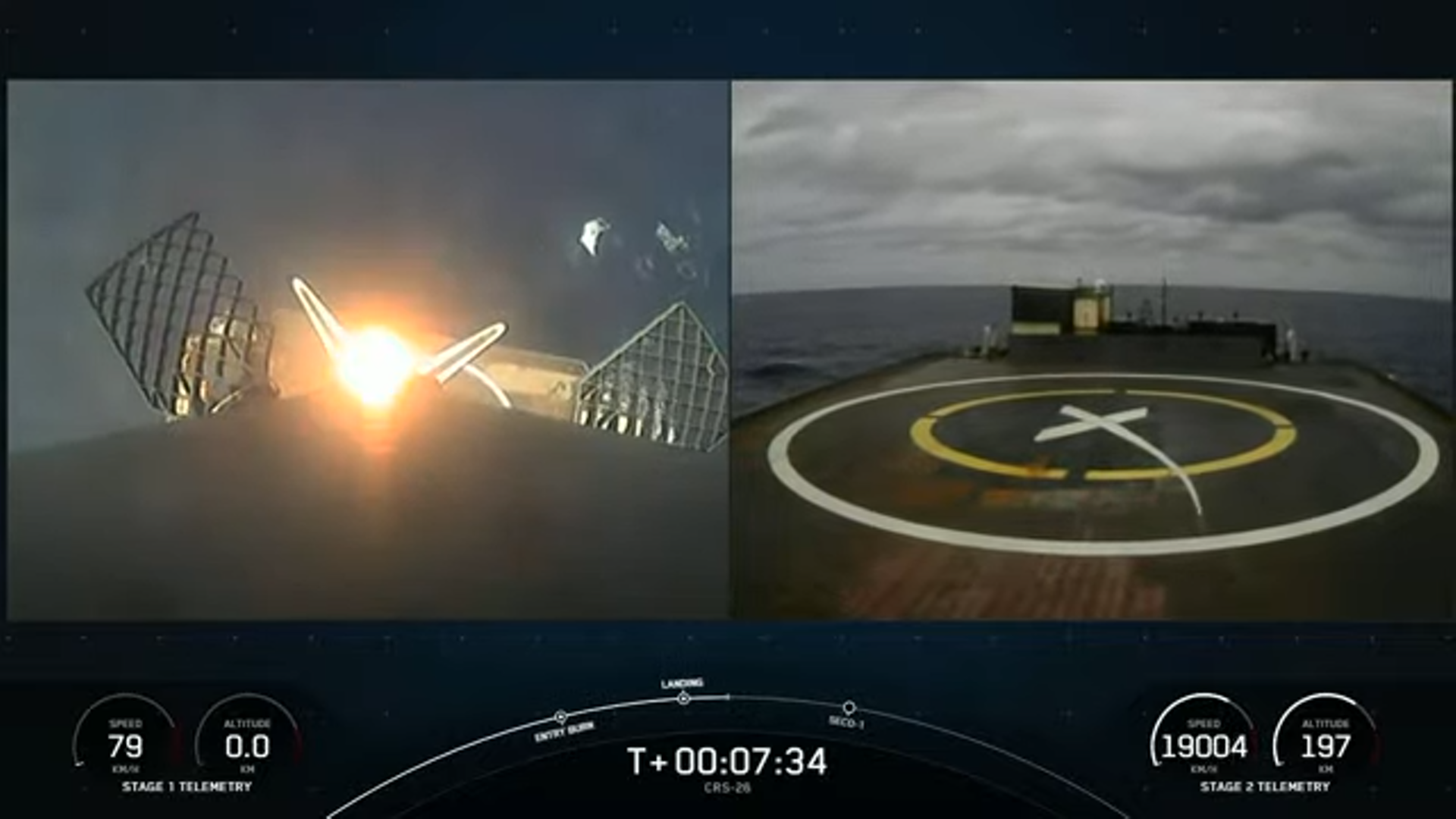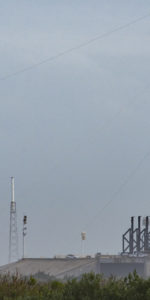
After being delayed since Tuesday following poor weather on the Space Coast, a brand-new SpaceX Cargo Dragon is zeroing-in on the International Space Station (ISS), with an expectation that it will reach the sprawling orbital outpost early Sunday morning. The CRS-26 mission—flying under the second-round Commercial Resupply Services (CRS2) contract between NASA and SpaceX—took flight from historic Pad 39A at the Kennedy Space Center (KSC) in Florida at 2:20 p.m. EST Saturday, laden with 7,777 pounds (3,528 kilograms) of experiments, payloads and supplies for the incumbent Expedition 68 crew.

Signed back in January 2016, the maximum-potential $14 billion CRS2 contract allocated at least six payload-lifting flights apiece to SpaceX’s Cargo Dragon, Northrop Grumman Corp.’s Cygnus and Sierra Nevada Corp.’s shuttle-like Dream Chaser spaceplane.
Already, the earlier CRS1 contract, signed in December 2008, had seen 20 SpaceX Cargo Dragons truck a total of 95,000 pounds (43,000 kilograms) of cargo uphill to the ISS and 75,000 pounds (34,000 kilograms) back home between May 2012 and March 2020.

SpaceX initiated its CRS2 commitment in December 2020 with the CRS-21 flight, which became the first U.S. uncrewed visiting vehicle to autonomously dock—rather than be robotically “berthed”—at the space station. Four more missions followed in June, August and December of 2021, with CRS-25 completing its own month-long stay at the ISS last summer.
All told, SpaceX’s six inaugural CRS2 missions have launched around 37,000 pounds (17,000 kilograms) of equipment, payloads and supplies to successive ISS crews and to date have returned more than 20,000 pounds (9,000 kilograms) of samples, experiment results and equipment back to the hands of scientists and engineers on the ground.

Principal payloads heading uphill have included NanoRacks’ Bishop commercial airlock, Japan’s GITAI robotic arm technology demonstrator and two pairs of Boeing-built ISS Roll-Out Solar Arrays (iROSAs).
The first five CRS2 flights were executed using a pair of reusable Cargo Dragons. C208 flew three times, logging nearly 108 cumulative days in orbit, and C209 flew twice and totaled almost 71 days in space.

But today’s CRS-26 mission sees a new vehicle—C211—join the fleet. She will spend about a month aloft on her first ISS voyage, before returning to a parachute-assisted splashdown in the Atlantic Ocean after 45 days, in early January.
But SpaceX’s CRS2 commitment has already expanded well beyond its six basic flights. In October 2020, NASA contracted three further Cargo Dragon flights and earlier in 2022 another six were added, bringing the total up to 15 and spanning missions up to CRS-35 in 2026.

This newer Cargo Dragon has also driven down the flight duration between launch and arrival at the ISS, from an average of two to three days in the CRS1 incarnation to as little as 22 hours and 34 minutes in the case of last December’s CRS-24. And that achievement is set to be bettered early tomorrow morning when CRS-26 arrives at the station at 7:30 a.m. EST, a little more than 17 hours after liftoff.
Launch of CRS-26 was originally targeted for 18 November but was pushed a few days to the right in response to the recent onslaught of Hurricane Nicole, eventually settling on an “instantaneous” T-0 at 3:54 p.m. EST Tuesday, 22 November. That was expected to produce a scheduled docking around 5:57 a.m. EST Wednesday, a record-breaking 14-hour ground-to-ISS transit.

In readiness for launch, the Autonomous Spaceport Drone Ship (ASDS), “Just Read the Instructions”, put to sea out of Port Canaveral on Sunday, bound for a position offshore to recover the Falcon 9’s first stage. Designated “B1076”, the booster for Tuesday’s launch of CRS-26 became the fourth brand-new “single-stick” Falcon 9 to join the fleet this year.
But Mother Nature, as always, remained steadfastly in charge, pledging an iffy forecast with overcast skies and rain showers on Tuesday. And although the unsettled weather provided some “opportunities” for short-lived breaks, the 45th Weather Squadron at Patrick Space Force Base cautioned that “the chance the periodic weather break occurs” during Tuesday’s instantaneous launch window “remains low”.

“Cloudy conditions remain across the Spaceport…with easterly winds and isolated showers,” noted the 45th Weather Squadron in its L-1 update on Monday. “On Tuesday, a wave is likely to form in the vicinity of Florida, adding a threat of thunderstorms and increasing the depth of the clouds.”
All told, this presented a dismal picture for Tuesday afternoon, with only a 10-percent probability of Mother Nature playing ball at T-0. As the countdown clock ticked toward T-6 minutes, the prospects improved to 30-percent-favorable, but as the gloomy weather closed in the attempt was formally scrubbed at T-57 seconds and clocks were recycled for No Earlier Than (NET) 2:20 p.m. EST Saturday, where conditions were initially predicted to be around 60-percent-favorable.

Those conditions improved still further, eventually blessing CRS-26 with 70-90-percent favorability across three days from Saturday to Monday. “Deep moisture does not look to be present,” noted the 45th, “with only a small chance for showers, a pattern that continues into the primary launch opportunity Saturday afternoon.”
As clocks ticked toward T-0 on Saturday, weather sat at around 80-percent-favorable. At T-45 seconds, SpaceX Launch Director Mike Taylor gave a clipped “Go for Launch”.
B1076 powered smoothly uphill precisely on time at 2:20 p.m. EST, as the 230-foot-tall (70-meter) Falcon 9 took flight. Her nine Merlin 1D+ engines burned furiously for the first 2.5 minutes of ascent, before B1076 separated from the stack and headed for an on-point touchdown on JRTI.
The turn then came for the single Merlin 1D+ Vacuum engine of the second stage, which burned for six minutes to pre-position CRS-26 in its required deployment altitude. The cargo ship separated from the second stage a little over 12 minutes after launch.

After docking at the space-facing (or “zenith”) port of the station’s Harmony node, hatches will be opened and the incumbent Expedition 68 crew will begin unpacking the Cargo Dragon. Closely monitoring the approach and docking will be NASA astronauts Nicole Mann and Josh Cassada, who also oversaw the arrival of Northrop Grumman’s NG-18 Cygnus earlier this month.
As well as goodies for the astronauts and cosmonauts—and likely Christmas gifts—CRS-26 will arrive laden with a range of scientific investigations spanning life sciences to technology and construction to tomato cultivation.
That load includes 2,341 pounds (1,062 kilograms) of crew supplies, 2,066 pounds (937 kilograms) of scientific investigations, 55 pounds (25 kilograms) of Extravehicular Activity (EVA) gear, 653 pounds (296 kilograms) of vehicle hardware and 26 pounds (12 kilograms) of computer resources for the station’s incumbent Expedition 68 crew.
The Moon Microscope will test a kit for in-flight medical diagnoses, using a hand-held 60x-100x miniature digital microscope whose imagery can be transmitted directly to ground specialists. The kit could provide diagnostic capabilities for crew members in space or on the surfaces of the Moon or Mars and may support other tasks, such as testing water, foodstuffs and surfaces for contamination and imaging lunar specimens.

The Veg-05 experiment will expand the crop variety of the station’s on-board Veggie facility from its previous emphasis upon leafy greens to Red Robin dwarf tomato plants, which will be grown and tended for four months, with three “harvests”. This new phase of the ongoing Veggie research focuses on the impact of light quality and fertilizer on production, microbial food safety, nutritional value and taste acceptability.
The Extrusion study seeks to demonstrate the extrusion of photocurable liquid resins into customized forms under microgravity conditions, to create new structural geometries not possible on Earth. It may lay the groundwork for additive manufacturing (or “3D-printing”) of more complicated space structures with specifically tailored properties.

And BioNutrients-2 continues a series of experiments to understand and provide adequate nutrition to future space explorers. It will produce specific quantities of key nutrients from yogurt, a fermented milk product, known as “kefir”, and a yeast-based beverage.
Perhaps most visible aboard CRS-26’s large haul of payloads are the second of an eventual three sets of Boeing-built iROSAs, which will be installed onto six of the station’s eight legacy Solar Array Wings (SAWs) to “shadow” and augment their power-generating potential. As previously reported by AmericaSpace, iROSAs will support future ISS expansion and customers’ burgeoning payload needs, increasing the overall electrical power output from around 160 kilowatts to as much as 215 kilowatts.

Current plans have identified six power channels—2B and 4B on the P-6 truss, 4A on the P-4 truss, 1A and 3A on the S-4 truss and 1B on the S-6 truss—which would derive greatest benefit from having iROSAs in place. The first set of arrays were installed onto the 2B and 4B channels by Expedition 65 spacewalkers Shane Kimbrough and Thomas Pesquet in June 2021, with additional arrays set to be added in the near future.
Pyramidal “modification kits” have already been assembled by spacewalkers in support of the iROSAs destined for emplacement on Power Channels 3A, 4A and 1B. The new arrays heading uphill aboard CRS-26 will be installed onto the 3A and 4A locations during a pair of spacewalks by Expedition 68 astronauts Josh Cassada and Frank Rubio, currently targeted for no earlier than 3 and 19 December.






16 Comments
16 Pings & Trackbacks
Pingback:Northrop Grumman Launches NG-18 Cygnus to Space Station ... - AmericaSpace - World news | Fast news | Us News
Pingback:SpaceX Gears Up for Three Missions in Four Days, Including Falcon Heavy Return - AmericaSpace
Pingback:SpaceX Gears Up for Three Missions in Four Days, Including Falcon Heavy Return - Space News
Pingback:SpaceX mijote triade missions en quatre jours, lesquels le Falcon Heavy Return – spyxfamily-es
Pingback:SpaceX Aims for Two Launches Tonight, Watches Vandenberg Weather - AmericaSpace
Pingback:SpaceX Aims for Two Launches Tonight, Watches Vandenberg Weather - Space News
Pingback:SpaceX jette ce brunante, gardez un œil sur la météo de Vandenberg – spyxfamily-es
Pingback:After Six-Week Stay, CRS-26 Dragon Departs Space Station, Heads Home - AmericaSpace
Pingback:After Six-Week Stay, CRS-26 Dragon Departs Space Station, Heads Home - Space News
Pingback:SpaceX Launches 40 OneWebs, Delays Vandenberg Starlink Mission - AmericaSpace
Pingback:Crew-6 Arrives in Florida, Heads for Monday Pre-Dawn Launch to Space Station - AmericaSpace
Pingback:Crew-6 Arrives in Florida, Heads for Monday Pre-Dawn Launch to Space Station - Space News
Pingback:SpaceX Misses Monday Triple-Header, As Falcon 9 Launch Schedule Realigns - AmericaSpace
Pingback:SpaceX Misses Monday Triple-Header, As Falcon 9 Launch Schedule Realigns - Space News
Pingback:Crew-5 Splashes Down, Wraps Up Five-Month ISS Mission - AmericaSpace
Pingback:SpaceX Flies Hosted Mission for Intelsat & NASA, Heads for Year’s 25th Mission - AmericaSpace